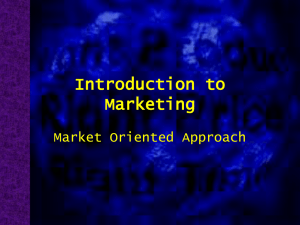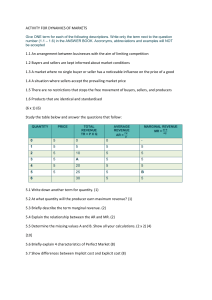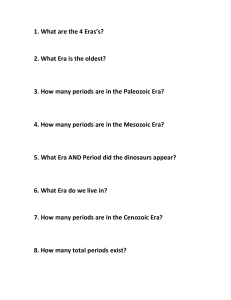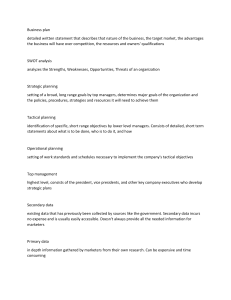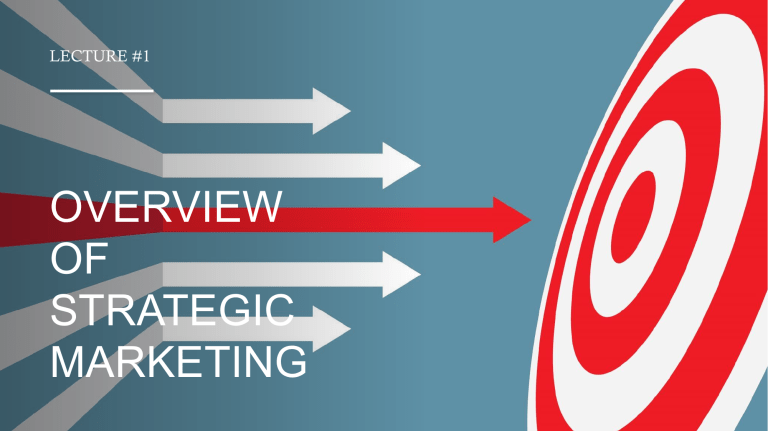
LECTURE #1 OVERVIEW OF STRATEGIC MARKETING MARKETING FACILITATES EXCHANGE BETWEEN BUYERS AND SELLERS MARKETING PROVIDES INFORMATION ABOUT WHAT CUSTOMERS WANT • Marketing research • Marketing information systems • Data Analytics (“Big data”) MARKETING BRIDGES THE PHYSICAL GAP BETWEEN COMPANIES AND CUSTOMERS COMMUNICATIO N WITH CUSTOMERS • Advertising • Social Media • Sales Promotions • Personal Selling HOW MUCH SHOULD WE CHARGE? • How much does it cost us to make and sell the product? • How much do we want to make on each product we sell (how much profit?) • How much are customers willing to pay? WHAT DO MARKETERS DO? Develop and manage products that will satisfy customer needs. Communicate with customers to help them learn about products. Make products available in the right place and at the right time. Price products in a way that is acceptable to the buyer and profitable for the company. THE “MARKETING MIX” THE “4P’S OF MARKETING” (Distribution) MARKETING CREATES • Value = Benefits – Costs VALUE • Value=what customer perceives as the benefits of a product. • Benefits include anything a buyer receives in an exchange. • Costs include anything a buyer gives up to obtain the benefits of the product • Money • Time • Effort • Risk EXCHANGES BETWEEN BUYERS AND SELLERS MARKETING CAN INVOLVE SEVERAL “STAKEHOLDERS” Customers Employees Governments Investors and shareholders Communities Suppliers Competitors THE “MARKETING ENVIRONMENT” FORCES THAT IMPACT BUYERS AND SELLERS Competitive forces Economic forces Political forces Legal & regulatory forces Technological forces Sociocultural forces STRATEGIC MARKETING THE ”MARKETING CONCEPT” Customer satisfaction should be the focus of the company Long-term profits are derived from satisfying customers The company must continue to keep up with changing customer needs and wants A LITTLE BIT OF HISTORY… The Evolution of the Marketing Concept THE “BARTER ERA” • Self sufficiency • Exchange one resource for another • Trading posts • Traveling salespeople • General stores • Still practiced in lesser developed countries and in developed economies in special cases THE “PRODUCTION ERA” • Began for developed countries with the Industrial Revolution of the late 1800s. • For developing countries, efforts to industrialize are still ongoing. • Mass production • Better transportation • More efficient technology • Demand exceeds supply • Goal is to lift production to meet demand THE “PRODUCTION ERA” “You can have any color you like, as long as it’s black” —Henry Ford THE “SALES” ERA (1930’S-1950’S) • Supply can now meet demand • The selling process becomes a key focus of business • Still, little consideration for consumer tastes. • The goal is to make consumers want what the company sells THE “SELLING” PHILOSOPHY MARKETING DEPARTMENT ERA Supply exceed demand (1960’S-1970’S) • • Research is used to understand consumer needs and wants • Increased competition • Marketing is viewed as a secondary function within the firm. THE MARKETING CONCEPT ERA Marketing has an integrated comprehensive role (1970’S—PRESENT) • • The linchpins of the marketing company era: • A company-wide focus on marketing • Customer service • Customer satisfaction • Relationship marketing BUILDING LONG-TERM CUSTOMER RELATIONSHIP • Customer Relationship S Management • Establishing a long-term mutually satisfying buyer-seller relationship • Continual effort to understanding the changing needs of customers • Based on trust • Customer Lifetime Value (CLV)
